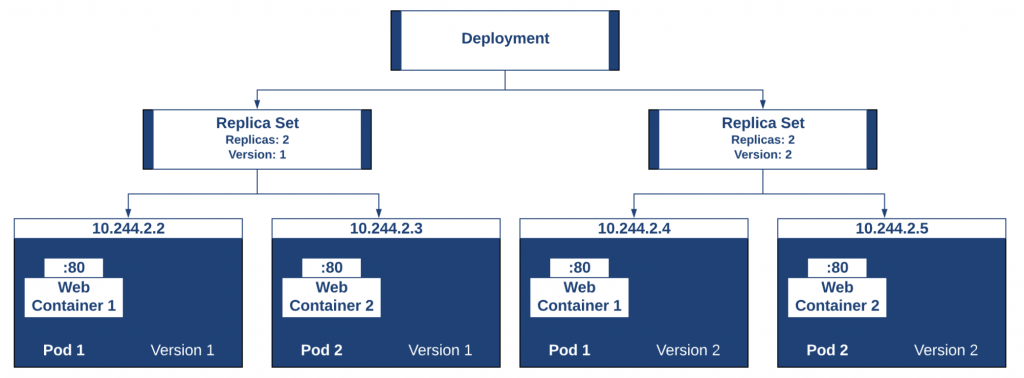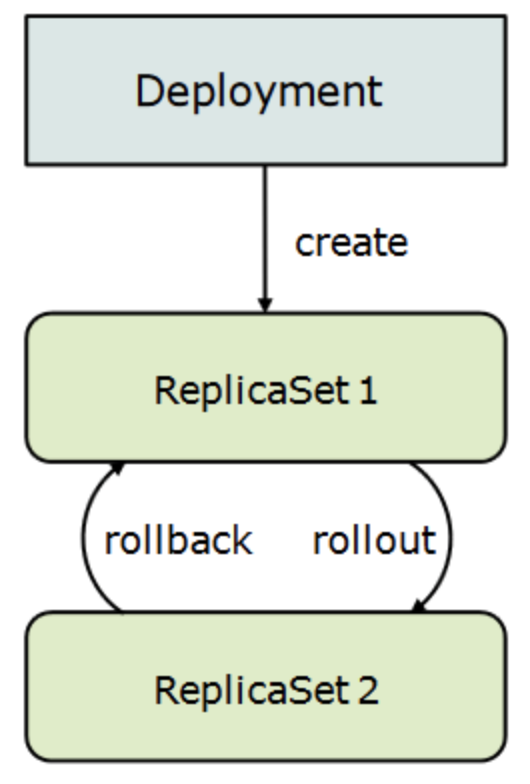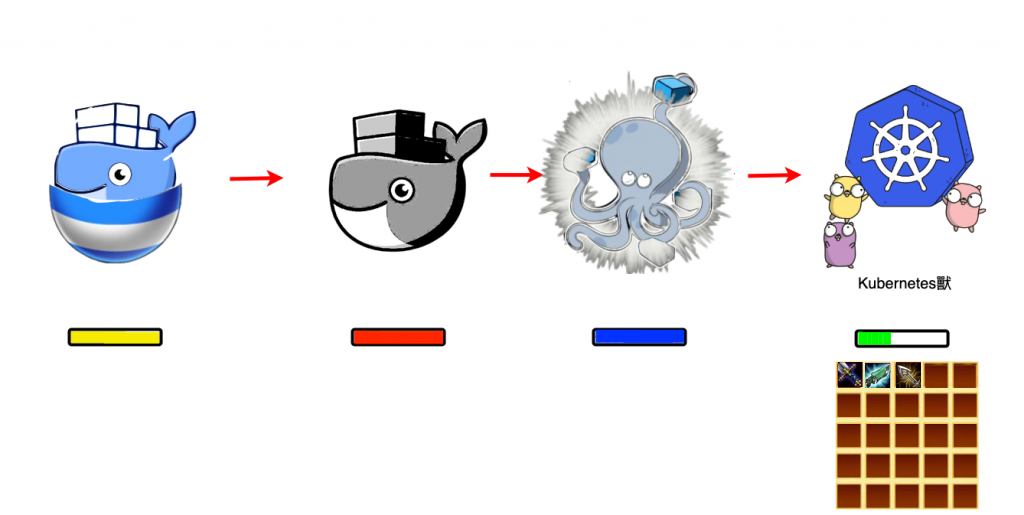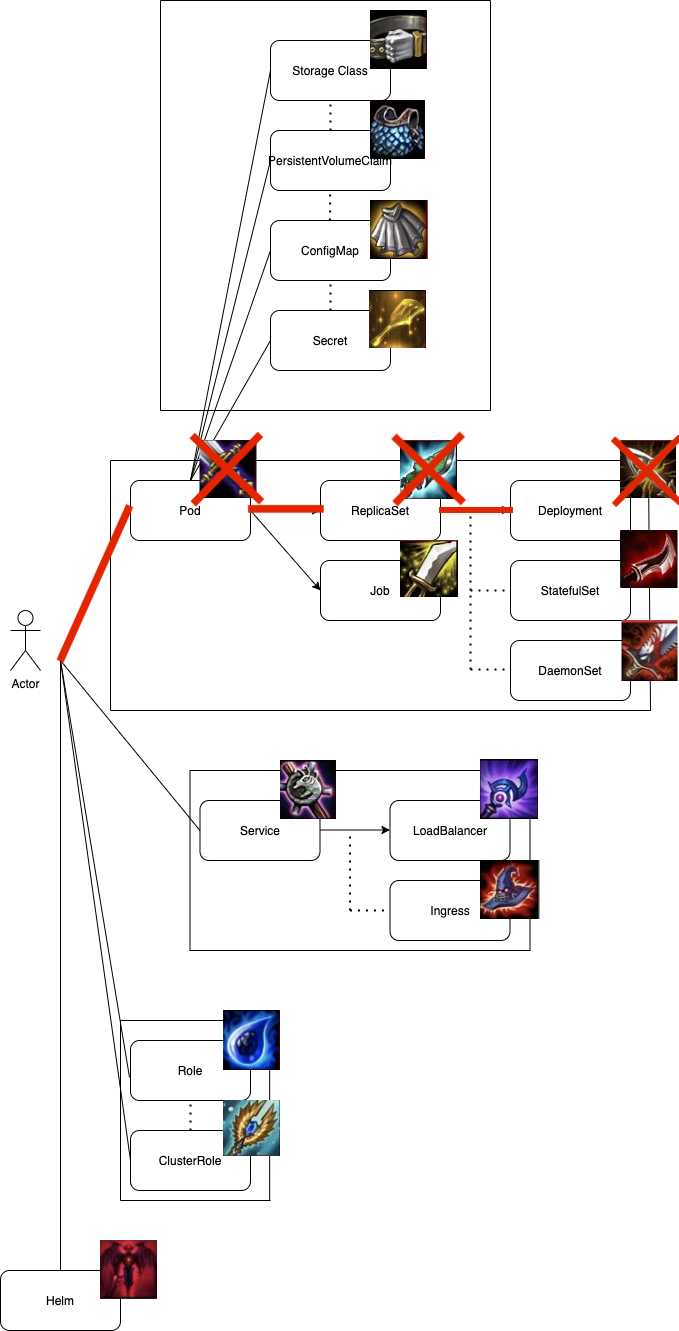上篇Day-18 Pod, ReplicaSet and deployment(上)我們講到了Pod與ReplicaSet的概念與運用,並且各帶一個範例展示,那本篇章要開始說他們的老大哥deployment了,並且在本章節的中後段會將
Day-12 Write your docker-compose中的docker-compose.yaml轉換成deployment.yaml。
希望能透過實際的例子拋磚引玉,讓大家都夠熟悉從docker-compose到deployment的思維與過程。
上期我們提到ReplicaSet是因為Replicas的不同(想穩定有N個相同的Pod在運行著)所以衍生出來的管理工具,那Deployment就是之於ReplicaSet上面的老大哥了,這也就是我會建議大家直接撰寫Deployment.yaml而非ReplicaSet或Pod的原因。
在下個段落會開始描述Deployment的理念及和ReplicaSet間的愛恨情仇,那我們就繼續看下去吧。

Deployment提供了一個Solution去有效的處理Pod Sets(ReplicaSet & Pod replicas)的Rolling Update / Rolling Back。
因此我們會用Depolyment來做到以下幾件事情:
當deployment生成時會一併創立並管理著一個ReplicaSet,而ReplcaSet則管理著Pod set。
那當服務進行版本更動時,則會生成新版本的ReplicaSet。

新版本的ReplicaSet可能有著與舊版本不同的Replicas,並且兩個ReplicaSets會並存,直到新版本的ReplicSet與指定數量的Pod可以正常運作為止。

確認新版ReplicaSet與Pod能正常運作後,才會刪除舊版ReplicaSet,並宣布完成版本變更。

deployment與replicaSet的yaml差別只在rolling update相關的key-value,那這部分會在下個環節介紹,這邊主要是展示給大家deployment的運行與狀態。
nginx_deployment.yaml
apiVersion: apps/v1
kind: Deployment
metadata:
name: nginx
labels:
name: nginx
app: nginx
spec:
replicas: 3
selector:
matchLabels:
app: nginx
template:
metadata:
labels:
app: nginx
spec:
containers:
- name: nginx
image: nginx
ports:
- containerPort: 80
那我們開始來部署deployment
$ kubectl apply -f nginx_deployment.yaml
deployment.apps/nginx created
部署完來確認一下deployment的狀態
$ Name: nginx
Namespace: default
CreationTimestamp: Sun, 27 Sep 2020 16:37:58 +0800
Labels: app=nginx
name=nginx
Annotations: deployment.kubernetes.io/revision: 1
kubectl.kubernetes.io/last-applied-configuration:
{"apiVersion":"apps/v1","kind":"Deployment","metadata":{"annotations":{},"labels":{"app":"nginx","name":"nginx"},"name":"nginx","namespace...
Selector: app=nginx
Replicas: 3 desired | 3 updated | 3 total | 3 available | 0 unavailable
StrategyType: RollingUpdate
MinReadySeconds: 0
RollingUpdateStrategy: 25% max unavailable, 25% max surge
Pod Template:
Labels: app=nginx
Containers:
nginx:
Image: nginx
Port: 80/TCP
Host Port: 0/TCP
Environment: <none>
Mounts: <none>
Volumes: <none>
Conditions:
Type Status Reason
---- ------ ------
Available True MinimumReplicasAvailable
Progressing True NewReplicaSetAvailable
OldReplicaSets: <none>
NewReplicaSet: nginx-d46f5678b (3/3 replicas created)
Events:
Type Reason Age From Message
---- ------ ---- ---- -------
Normal ScalingReplicaSet 9m53s deployment-controller Scaled up replica set nginx-d46f5678b to 3
接下來我們進行版本的更替,並來查看一下deployment的變化
$ kubectl set image deploy/nginx nginx=nginx:stable
deployment.apps/nginx image updated
$ kubectl rollout status deploy nginx
Waiting for deployment "nginx" rollout to finish: 1 out of 3 new replicas have been updated...
Waiting for deployment "nginx" rollout to finish: 1 out of 3 new replicas have been updated...
Waiting for deployment "nginx" rollout to finish: 2 out of 3 new replicas have been updated...
Waiting for deployment "nginx" rollout to finish: 2 out of 3 new replicas have been updated...
Waiting for deployment "nginx" rollout to finish: 2 out of 3 new replicas have been updated...
Waiting for deployment "nginx" rollout to finish: 2 out of 3 new replicas have been updated...
Waiting for deployment "nginx" rollout to finish: 1 old replicas are pending termination...
Waiting for deployment "nginx" rollout to finish: 1 old replicas are pending termination...
deployment "nginx" successfully rolled out
那像以往一樣,我們來寫點Code吧!
我們一樣把Day-12 Write your docker-compose 的yaml為例,試著將它轉換成deployment

我們來將這三個containers放進同個pod,並且加上replicas與rolling strategy試試吧
我們來解析一下這份yaml吧:
version: '3'
services:
nginx:
container_name: nginx
image: nginx
ports:
- "80:80"
volumes:
- ./nginx/nginx.conf:/etc/nginx/nginx.conf
- ./nginx/default.conf:/etc/nginx/conf.d/default.conf
restart: always
networks:
- ironman-net
redis:
container_name: redis
image: redis:4.0
ports:
- "6379:6379"
restart: always
networks:
- ironman-net
ironman:
container_name: ironman
image: ghjjhg567/ironman:latest
volumes:
- ./app/:/usr/src/app/app
env_file:
- prd.env
restart: always
networks:
- ironman-net
networks:
ironman-net:
driver: bridge
Tips:
說完了我們的需求以及解說了些不會在這次實作的部分之後,我們來寫code吧!
我們先撰寫個deployment的template。在定義好api版本與deployment的info之後,
apiVersion: apps/v1
kind: Deployment
metadata:
name: ironman
labels:
name: ironman
app: ironman
spec:
minReadySeconds: 5
strategy:
type: RollingUpdate
rollingUpdate:
maxSurge: 1
maxUnavailable: 1
接下來我們補上ReplicaSet的部分吧!
這部分由於我們在Day-18 Pod, ReplicaSet and deployment(上)說過了,因此我們略過,有需要的朋友再去看一下那個章節。
apiVersion: apps/v1
kind: Deployment
metadata:
name: ironman
labels:
name: ironman
app: ironman
spec:
minReadySeconds: 5
strategy:
type: RollingUpdate
rollingUpdate:
maxSurge: 1
maxUnavailable: 1
replicas: 1
selector:
matchLabels:
app: ironman
最後則是三個containers的部分,我就先寫成yaml再來解說吧!
apiVersion: apps/v1
kind: Deployment
metadata:
name: ironman
labels:
name: ironman
app: ironman
spec:
minReadySeconds: 5
strategy:
type: RollingUpdate
rollingUpdate:
maxSurge: 1
maxUnavailable: 1
replicas: 1
selector:
matchLabels:
app: ironman
template:
metadata:
labels:
app: ironman
spec:
containers:
- name: ironman
image: ghjjhg567/ironman:latest
imagePullPolicy: Always
resources:
limits:
cpu: "1"
memory: "2Gi"
requests:
cpu: 500m
memory: 256Mi
ports:
- containerPort: 8100
envFrom:
- configMapRef:
name: iroman-config
- name: redis
image: redis:4.0
imagePullPolicy: Always
ports:
- containerPort: 6379
- name: nginx
image: nginx
imagePullPolicy: Always
ports:
- containerPort: 80
volumeMounts:
- mountPath: /etc/nginx/nginx.conf
name: nginx-conf-volume
subPath: nginx.conf
readOnly: true
- mountPath: /etc/nginx/conf.d/default.conf
subPath: default.conf
name: nginx-route-volume
readOnly: true
readinessProbe:
httpGet:
path: /v1/hc
port: 80
initialDelaySeconds: 5
periodSeconds: 10
volumes:
- name: nginx-conf-volume
configMap:
name: nginx-config
- name: nginx-route-volume
configMap:
name: nginx-route-volume
$ kubectl apply -f ironman_config.yaml
secret/ironman-config created
$ cd nginx
$ kubectl create configmap nginx-config --from-file=nginx.conf
configmap/nginx-config created
$ kubectl create configmap nginx-route-volume --from-file=default.conf
configmap/nginx-route-volume created
$ cd ..
$ kubectl apply -f deployment.yaml
$ kubectl get pod --watch
NAME READY STATUS RESTARTS AGE
ironman-6d655d444d-jwf4b 0/3 ContainerCreating 0 6s
ironman-6d655d444d-rrbf6 2/3 Terminating 0 45m
ironman-6d655d444d-rrbf6 0/3 Terminating 0 45m
ironman-6d655d444d-rrbf6 0/3 Terminating 0 45m
ironman-6d655d444d-rrbf6 0/3 Terminating 0 45m
ironman-6d655d444d-jwf4b 2/3 Running 0 35s
ironman-6d655d444d-jwf4b 3/3 Running 0 46s
configMap, secrets與其他Kubernetes設定中的其他物件,會在後面章節中詳細講解。
由於從docker的bridge network —> kubernetes pod,所有的containers都能利用同個pod的資源並透過localhost溝通,因此需要修改config當中原有透過container name當作host的variables
nginx/default.conf
ironman:8100 → 127.0.0.1:8100
server {
listen 80;
server_name local;
resolver 127.0.0.11;
resolver_timeout 5s;
location / {
include uwsgi_params;
uwsgi_pass 127.0.0.1:8100;
uwsgi_read_timeout 900;
client_body_timeout 900;
}
}
ironman_config.yaml
redis → MTI3LjAuMC4x(127.0.0.1)
apiVersion: v1
kind: Secret
metadata:
name: ironman-config
type: Opaq
data:
REDIS_HOST: MTI3LjAuMC4x
REDIS_PORT: NjM3OQ==
這裡的REDIS_HOST指的是127.0.0.1,但由於被encode64,因此在configmap上看到的是加密後的結果。
本篇章所有程式碼將放在下面的github project當中的branch day-19
https://github.com/Neskem/ironman_2020/tree/day-19
在這章節中,我們了解了deployment, replicaSet與Pod間的關係,並成功的將docker-compose轉化成了deployment,也透readinessProbe證實它正常運作著。 那在下個章節我們將介紹ConfigMap與Secret,讓我們把本篇章所遺漏的部分給補足!


https://kubernetes.io/docs/concepts/workloads/controllers/deployment/
